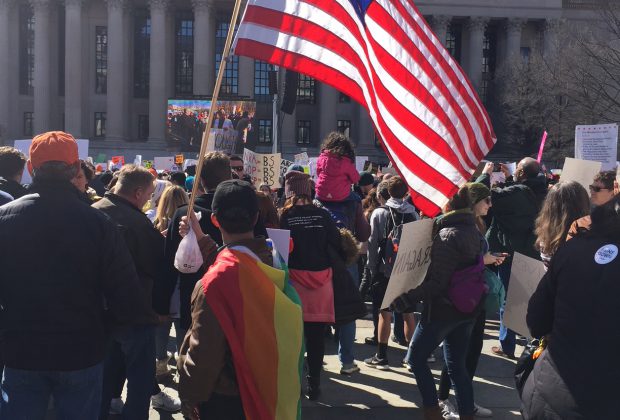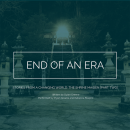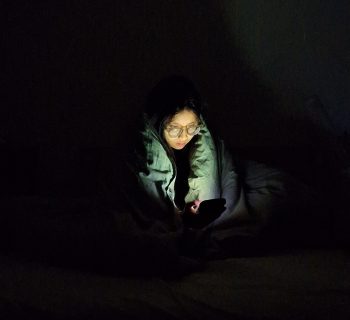James Hanmer
*Articles reflect the views of the author and or those quoted and do not necessarily represent the views of CCBC or the CCBC Connection.
Seating on the metro was surprisingly abundant. The conversation between a woman selling homemade #Neveragain tee shirts for $6 per and a mother and her young daughter was quickly drowned out as the leafless trees beyond an unwashed window became a brown blur. By the Mt. Vernon Square station, in northeastern D.C., the train was brimming with march goers – smartly dressed yuppies with signs resting on Patagonia jacket-clad shoulders, students with fluorescent dyed hair and vintage Levi’s - standing shoulder to shoulder several stories beneath the nation’s capital.
March for Our Lives was not a march, but rather a stagnant rally, wherein, according to the Virginia based firm, Digital Design & Imaging Service, some 200 thousand protestors congregated near Capitol Hill, vying to end gun violence and more specifically mass shootings in American schools. The Community College of Baltimore County sponsored a bus taking students to the event free of cost.
When Marjory Stoneman Douglas High School students banded together in the wake of disaster to form the #Neveragain movement, it gained major clout across social media platforms and snowballed into March for Our Lives. The March for Our Lives website says that the, “organizers are the kids themselves,” and that “they have brought in support to help ensure it is a success.” That “support” was Everytown for Gun Safety, a 501(c)(4) social welfare organization started in 2014 with a generous $50 million donation from former New York City mayor and billionaire Michael Bloomberg.
To ensure success, organizers paid for a concert-audio equipped main stage, a handful of high definition stadium style television screens mounted in the streets and live performances by Vic Mensa, Ariana Grande, Demi Lovato, and Lin Manuel Miranda – to name a few.
Everytown has been in the news recently for its claim that the Parkland, Florida, school shooting was the 18th to occur in 2018, a fact repudiated by The Washington Post among others. Though not a blatant lie, the statistic is deliberately easy to misinterpret, as Everytown defines a school shooting as, “any time a firearm discharges a live round inside a school building or on a school campus or grounds,” which encompasses discharges that occur after school hours and in which no one is injured.
Though public donations from a host of celebrities including Stephen Spielberg, George Clooney and Oprah Winfrey amounted to at least $3.65 million, according to Heavy.com, it is possible that additional funds for the event came from Everytown’s anonymous donors. This seems plausible when considering that Deena Kate, the Co-Executive Director of the Women’s March Los Angeles Foundation, is president of the board which decides how Everytown spends its donations.
Last year Everytown decided to contribute a total of $1.28 million spread between five lobbying firms to support legislation primarily directed at instituting universal background checks and revoking concealed carry permits, according to the Senate Office of Public Records. Everytown will reportedly be investing $25 million in this year’s upcoming elections.
The event’s professional orchestration included barricaded streets, a perimeter of National Guardsmen stationed adjacent to their armored vehicles and officers of the United States Park Police interspersed throughout the crowd.
A Metropolitan Police Department Sergeant, who asked to remain nameless, said that, “it went very smoothly,” and “there were no real problems.” CCBC alumni and current University of Maryland Baltimore County Student, Andrew Psoras, agreed, stating that, “the march was anti-gun but also a positive expression advocating pro-votership, pro-participation, pro-democracy and pro-life, liberty, and the pursuit of happiness in the most literal sense.”
Upon ascending a broken escalator from the packed Archives Metro Station we were thrust into a sea of homemade cardboard signs bearing heartfelt, witty, satirical and most of all poignant messages addressed to Congressmen, lobbyists, President Trump, the GOP, and to victims of gun violence, to their families and to the United States public, urging anyone of age to fulfill their civic duty and vote so that tragedies like the Parkland mass shooting may once and for all be left where they belong - alongside slavery in the annals of American deplorability.
Video sequences were broadcast on the massive television screens that showed Sean Hannity screaming at panelists on Fox News, a red-faced Alex Jones espousing conspiracy theories about paid crisis-actors and National Rifle Association members toting AR-15s, which were cut to an ominous score with rapid-fire statistics about gun violence in the United States. Although Everytown did not respond to an email inquiring as to the videos’ origin, their high production value made it apparent that they were not produced by Parkland students.
But propaganda videos and pop singers were not the focus at March for Our Lives. Miley Cyrus’s “The Climb” did not inspire 400 thousand hands to clap in unison to an African rhythm, as did Alex King, a young man from Chicago who lost his nephew to a stray bullet. The singers, though talented, were simply filler for the time between speeches delivered by students who survived the Parkland shooting and by black and Hispanic youths affected by gun violence in their communities. These speeches were made often with choked up throats and watery eyes, and were so emotionally charged that one speaker vomited at the podium.
And the emotions these speakers displayed could not be quelled by thoughts and prayers. Instead Parkland students emphasized the need for concrete political action by Congress to prevent future mass shootings. Their support for specific policies however, was less congruous.
Delaney Tarr, a Parkland Senior, emphasized that students’ right to feel secure in school is contingent on a relaxed environment without weekly drills or airport style security. Another Parkland Senior, Ryan Deitsch, said he feels that the security measures typical of government institutions – metal detectors, x-ray machines, security personal – would be a step in the right direction. The STOP School Violence Act which received massive bi-partisan support in the House of Representatives and is now being debated in the Senate, where it is expected to meet a similarly positive reception from Democrats and Republicans alike, would increase federal funding for schools to implement heightened security measures.
None of the speakers voiced support for arming teachers in the classroom and of 104 anonymous marchers surveyed by The CCBC Connection, over 99 percent agreed. The survey also showed that 96 percent of marchers polled supported universal background checks, psychological evaluations and mandatory training programs for all firearm owners.
It was high noon and the sun had free reign over an azure sky, cloudless and harkening of warmer days, which have not been seen thus far in spring. The chanting was heard first as an indistinct rumble from our east, where the Capitol’s spire was just visible over an ornate marble roofline. It grew nearer and at last the words became audible. Suddenly the entire crowd had supplanted their discourse with one repeated phrase - “Vote them out!”
Tucked away in the spending bill Mr. Trump signed into law last week, which prevented a government shutdown via a $1.3 trillion expansion of the United States’ budget, is a long-awaited authorization for the Center for Disease Control to study gun violence as a public health issue.
Since 1996 the Dickey Amendment has prohibited the CDC from allocating injury prevention funds to promote gun control. However, some experts are doubtful that any substantial portion of the CDC’s relatively meager funding – it has requested a $5.66 billion budget for 2019 compared to the Department of Defense’s budget request of $716 billion – will be directed towards gun violence research.
Additionally, because mass shootings only account for “Less than one percent of gun murder[s],” according to a study by Everytown’s predecessor, Mayors Against Illegal Guns, the CDC is more likely to focus on gun related homicides in urban areas. City College Senior, Nicolas Shanosky, says he attended March for Our Lives to “stop inner-city gun violence” in Baltimore. The Baltimore Sun reported that of the City’s 343 homicide victims in 2017 at least 300 were killed with a firearm.
However, even if the CDC manages to produce ground-breaking research on the causes of mass shootings and advises lawmakers on specific policies to prevent them, there is no guarantee that Congress will take legislative action accordingly.
Bob Goodlatte, the Republican Senator from Virginia and Chairman of the Senate Judiciary Committee, told The Hill that he supported lifting the CDC’s ban on studying gun violence because, “the core pursuit of the Center for Disease Control…is to prevent disease,” and “not to address issues related to things that happen because someone has a disease like mental illness.”
Any policy increasing the difficulty of obtaining firearms enacted by Congress will also meet inevitable backlash from the NRA and many gun owners, even though it is estimated that over 70 percent of NRA members and a higher percentage of Americans support universal background checks.
Bryan Belize, an Army Airborne Veteran who served in Iraq and Afghanistan, said the firearm owners he knows see Second Amendment rights as a zero-sum game; “To them, it’s a black and white issue – a slippery slope.” Charlie Kirk, a lifetime NRA Member, reinforced this assertion in saying that “once you give up your rights, don’t expect to get them back.”
Belize feels the answer is not as simple, but rather requires legislation that takes technical details which contribute to a firearm’s lethality into account. He also commented that rate of fire should not be the focus of gun violence debates, since a firearm’s recoil makes fully automatic discharges incredibly inaccurate. Belize said that “a lot of discussion between both sides” is necessary to create policy that validates citizens’ disparate views on firearm regulation, but that “any action over inaction” is needed at this point. Belize also said he supports a minimum age of 21 years to purchase any firearms.
The March for Our Lives website claims that the organization does not wish to infringe on “the right of law-abiding Americans to keep and bear arms,” so long as those arms are not “assault weapons…like the ones used in Las Vegas” and in seven of the other “deadliest mass shootings of the past decade.” In the mass shootings mentioned, firearms used by shooters included semi-automatic rifles, semi-automatic handguns, semi-automatic shotguns and pump action shotguns. The website also enumerates a desire to prohibit the sale of “high-capacity” magazines and to better enforce the background checks already required to purchase a firearm.
For Will Grant, a CCBC Student studying political science, March for Our Lives’ failure to explicitly define which firearms they wish to restrict “for use by our military and law enforcement only,” and what number of rounds they feel a magazine should be limited to made him weary of supporting the movement. Grant said he does support stricter enforcement of the current background check laws in place in the United States, which March for Our Lives also advocates.
Several days after the march former Supreme Court Associate Justice John Paul Stevens contributed an op-ed piece to The New York Times in which he lauded young Americans for their “civic engagement” at March for Our Lives. Stevens went on to write that instead of the three policies March for Our Lives advocates, the group should “demand a repeal of the Second Amendment,” which he considers a “relic of the 18th century.”
Stevens pointed to the landmark Supreme Court case, District of Columbia v. Heller, wherein a long-standing ban on handgun ownership was overturned and the primary directive of the Second Amendment was re-interpreted as chiefly pertaining to citizens’ right to self-defense instead their right to form a militia, as the beginning of an NRA dominated era in the debate on gun violence. Stevens dissented in the case and feels that it “provided the NRA with a propaganda weapon of immense power.”
John Dedie, a Professor of Political Science at CCBC, said that, “we will never repeal the Second Amendment.” Dedie feels that the already fiery debate on gun control legislation is only fueled by Democrats’ constant attempts to introduce new and sweeping reforms, like the Ammunition Background Check Act, which are likely to galvanize staunch Second Amendment rights advocates further, instead of making American schools safer.
Marchers’ opinions gleaned from the same study conducted by The CCBC Connection indicated that 47 percent supported the outright abolition of the Second Amendment. However, of those 47 percent, high school students were 21 percent more likely to support its abolition than those beyond college, and middle school students were 3 percent more likely to support its abolition than high schoolers.
Older marchers polled were not only less likely to support striking down the Second Amendment, but were also less likely to identify as Democrats: 89 percent of middle and high schoolers identified as Democrats whereas 69 percent of college students, graduate students and those beyond college identified as Democrats. A single marcher identified as Republican, 4 percent identified with an unspecified third party and 13 percent identified as Independent voters.
Despite the largely homogenous political make-up of the crowd, speakers and protestors both emphasized that gun violence is a non-partisan issue. They and the American public now look to Congress to adopt that sentiment and reach across the aisle before another mass shooting can befall the nation.
Emma Gonzales read in slow succession 17 names, all victims of the Parkland shooting. A single tear left its salty imprint on her left cheek, as have countless tears shed by those in the audience. She now stood unwavering in an army green jacket festooned with pins, her closely shaven head held high, until six minutes and twenty seconds have elapsed – the time it took one man to extinguish combined centuries of life on a February day in Florida. But winter has passed and spring has taken hold of the nation. The cherry trees are blossoming and their myriad flowers will not be swept away in the March winds, nor will they be brought down by the April rain, nor will they shrivel and fade when the sweltering heat of the July sun beats down upon them ceaselessly. For once their pungent nectar reeks of permanence, of a new tomorrow and of an era when fear for one’s life is not the cost of a public education. This bloom is not fleeting; it is only just beginning.
*Articles reflect the views of the author and or those quoted and do not necessarily represent the views of CCBC or the CCBC Connection.














This is an important topic which needs to have more awareness brought to it.
This topic needs to be shown throughout the country and we need to start implementing laws to stop senseless violence. It’s way too easy to obtain guns nowadays and all these senseless killings won’t do any good for our country and this is why we have to incite change. We are the only country who keeps having to deal with this type of unnecessary violence.